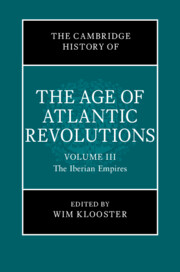Book contents
- The Cambridge History of the Age of Atlantic Revolutions
- The Cambridge History of the Age of Atlantic Revolutions
- The Cambridge History of the Age of Atlantic Revolutions
- Copyright page
- Contents
- Figures
- Maps
- Tables
- Contributors to Volume III
- Preface
- Introduction
- Part I The Spanish Empire
- 1 The Spanish Empire: General Overview
- 2 The Spanish Empire on the Eve of American Independence
- 3 The Cortes of Cádiz and the Spanish Liberal Revolution of 1810–1814: Atlantic and Spanish American Dimensions
- 4 The Constitutional Triennium in Spain, 1820–1823
- 5 Mexico: From Civil War to the War of Independence, 1808–1825
- 6 Central America
- 7 War and Revolution in the Southern Cone, 1808–1824
- 8 Caribbean South America: Free People of Color, Republican Experiments, Military Strategies, and the Caribbean Connection on the Path to Independence
- 9 The Southernmost Revolution: The Río de la Plata in the Early Nineteenth Century
- 10 Royalists, Monarchy, and Political Transformation in the Spanish Atlantic World during the Age of Revolutions
- 11 Africans and Their Descendants in the Spanish Empire in the Age of Revolutions
- 12 Concepts on the Move: Constitution, Citizenship, Federalism, and Liberalism across Spain and Spanish Atlantic
- 13 Patriarchy, Misogyny, and Politics in the Age of Revolutions
- 14 Impact of the French Caribbean Revolutions in Continental Iberian America, 1791–1833
- 15 Deferred but not Avoided: Great Britain and Latin American Independence
- Part II Brazil, Portugal, and Africa
- Index
7 - War and Revolution in the Southern Cone, 1808–1824
from Part I - The Spanish Empire
Published online by Cambridge University Press: 20 October 2023
- The Cambridge History of the Age of Atlantic Revolutions
- The Cambridge History of the Age of Atlantic Revolutions
- The Cambridge History of the Age of Atlantic Revolutions
- Copyright page
- Contents
- Figures
- Maps
- Tables
- Contributors to Volume III
- Preface
- Introduction
- Part I The Spanish Empire
- 1 The Spanish Empire: General Overview
- 2 The Spanish Empire on the Eve of American Independence
- 3 The Cortes of Cádiz and the Spanish Liberal Revolution of 1810–1814: Atlantic and Spanish American Dimensions
- 4 The Constitutional Triennium in Spain, 1820–1823
- 5 Mexico: From Civil War to the War of Independence, 1808–1825
- 6 Central America
- 7 War and Revolution in the Southern Cone, 1808–1824
- 8 Caribbean South America: Free People of Color, Republican Experiments, Military Strategies, and the Caribbean Connection on the Path to Independence
- 9 The Southernmost Revolution: The Río de la Plata in the Early Nineteenth Century
- 10 Royalists, Monarchy, and Political Transformation in the Spanish Atlantic World during the Age of Revolutions
- 11 Africans and Their Descendants in the Spanish Empire in the Age of Revolutions
- 12 Concepts on the Move: Constitution, Citizenship, Federalism, and Liberalism across Spain and Spanish Atlantic
- 13 Patriarchy, Misogyny, and Politics in the Age of Revolutions
- 14 Impact of the French Caribbean Revolutions in Continental Iberian America, 1791–1833
- 15 Deferred but not Avoided: Great Britain and Latin American Independence
- Part II Brazil, Portugal, and Africa
- Index
Summary
The aim of this chapter is to study the main political-military events of the struggle for independence in the Southern Cone, specifically in current Buenos Aires, Santiago and Lima. These three cities experienced both a profound political revolution, and a bloody civil war in the period 1808-1824. The fact that this revolution was also a military conflict in which a significant number of South Americans participated on both sides of the battlefield suggests that independence was not a struggle for national liberation. A second hypothesis proposes that independences were consummated in the early 1820s once the three fledgling countries declared their sovereignty not only in relation to Spain, but also to their neighbors. Those who once fought together against the Madrid authorities gradually distanced themselves from each other, which is why the “Americanist” projects (both of José de San Martín and Simón Bolívar) lost legitimacy as time went by. Understanding the loss of that legitimacy is key when analyzing the origins of the South American national states. Indeed, thinking about Argentina, Chile and Peru requires not taking their existence for granted.
- Type
- Chapter
- Information
- The Cambridge History of the Age of Atlantic Revolutions , pp. 205 - 227Publisher: Cambridge University PressPrint publication year: 2023

